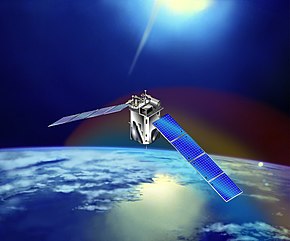 TIMED in low Earth orbit | |
| Names | Thermosphere • Ionosphere • Mesosphere • Energetics and Dynamics |
|---|---|
| Mission type | Ionosphere Atmospheric science Space weather research |
| Operator | NASA |
| COSPAR ID | 2001-055B |
| SATCAT no. | 26998 |
| Website | TIMED at APL |
| Mission duration | Planned: 2 years Elapsed: 22 years, 11 months, 15 days |
| Spacecraft properties | |
| Manufacturer | Applied Physics Laboratory |
| Launch mass | 660 kg (1,460 lb) |
| Dimensions | 2.72 meters high 11.73 meters wide 1.2 meters deep |
| Power | 406 watts |
| Start of mission | |
| Launch date | 7 December 2001, 15:07:35 UTC |
| Rocket | Delta II 7920-10 (Delta D289) |
| Launch site | Vandenberg, SLC-2W |
| Entered service | 22 January 2002 |
| Orbital parameters | |
| Reference system | Geocentric orbit[1] |
| Regime | Low Earth orbit |
| Altitude | 625 km (388 mi) |
| Inclination | 74.1° |
| Period | 97.3 minutes |
The TIMED (Thermosphere • Ionosphere • Mesosphere • Energetics and Dynamics) mission is dedicated to study the influences that energetics and dynamics of the Sun and humans have on the least explored and understood region of Earth's atmosphere – the Mesosphere and Lower Thermosphere / Ionosphere (MLTI). The mission was launched from Vandenberg Air Force Base in California on 7 December 2001 aboard a Delta II rocket launch vehicle. The project is sponsored and managed by NASA, while the spacecraft was designed and assembled by the Applied Physics Laboratory at Johns Hopkins University. The mission has been extended several times, and has now collected data over an entire solar cycle, which helps in its goal to differentiate the Sun's effects on the atmosphere from other effects.[2] It shared its Delta II launch vehicle with the Jason-1 oceanography mission.
- ^ "Trajectory: TIMED 2001-055B". NASA. 14 May 2020. Retrieved 23 November 2020.
 This article incorporates text from this source, which is in the public domain.
This article incorporates text from this source, which is in the public domain.
- ^ Fox, Karen. "Ten Successful Years of Mapping the Middle Atmosphere". NASA.
 This article incorporates text from this source, which is in the public domain.
This article incorporates text from this source, which is in the public domain.